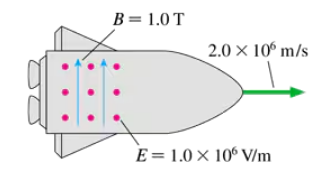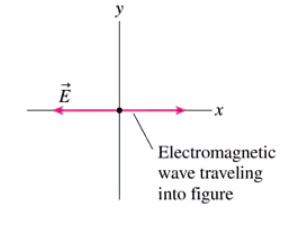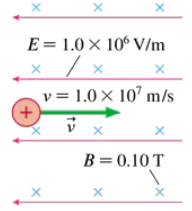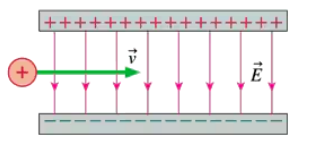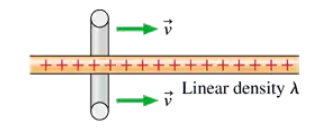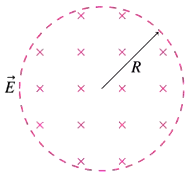 Back
BackProblem 2b
A rocket cruises past a laboratory at 1.00×106 m/s in the positive x-direction just as a proton is launched with velocity (in the laboratory frame) m/s. What are the proton's speed and its angle from the y-axis in the rocket frame?
Problem 4
A rocket zooms past the earth at v=2.0×106 m/s. Scientists on the rocket have created the electric and magnetic fields shown in FIGURE EX31.4. What are the fields measured by an earthbound scientist?
Problem 6
What capacitance, in μF, has its potential difference increasing at 1.0×106 V/s when the displacement current in the capacitor is 1.0 A?
Problem 8a
A 10-cm-diameter parallel-plate capacitor has a 1.0 mm spacing. The electric field between the plates is increasing at the rate 1.0×106 V/m s. What is the magnetic field strength on the axis?
Problem 9
Show that the quantity ϵ0(dΦe/dt) has units of current.
Problem 13a
The magnetic field of an electromagnetic wave in a vacuum is , where x is in m and t is in s. What are the wave's wavelength?
Problem 14c
The electric field of an electromagnetic wave in a vacuum is , where x is in m and t is in s. What are the wave's magnetic field amplitude?
Problem 18
A radio receiver can detect signals with electric field amplitudes as small as 300 μV/m. What is the intensity of the smallest detectable signal?
Problem 21
A microwave beam with a wavelength of 1.5 cm has an intensity of 25 W/m2. What is the magnetic field amplitude?
Problem 23a
FIGURE EX31.23 shows a horizontally polarized radio wave of frequency 1.0×106 Hz traveling into the figure. The maximum electric field strength is 1000 V/m. What is the maximum magnetic field strength?
Problem 26
Unpolarized light with intensity 350 W/m2 passes first through a polarizing filter with its axis vertical, then through a second polarizing filter. It emerges from the second filter with intensity 131 W/m2. What is the angle from vertical of the axis of the second polarizing filter?
Problem 28
What is the force (magnitude and direction) on the proton in FIGURE P31.28? Give the direction as an angle cw or ccw from vertical.
Problem 29c
A proton is fired with a speed of 1.0×106 m/s through the parallel-plate capacitor shown in FIGURE P31.29. The capacitor's electric field is E =(1.0×105 V/m, down). How does an experimenter in the proton's frame explain that the proton experiences no force as the charged plates fly by?
Problem 31
An electron travels with through a point in space where and . What is the force on the electron?
Problem 32d
In FIGURE P31.32, a circular loop of radius r travels with speed v along a charged wire having linear charge density λ. The wire is at rest in the laboratory frame, and it passes through the center of the loop. What electric and magnetic fields would an experimenter in the loop's frame calculate at distance r from the current of part c?
Problem 34b
A simple series circuit consists of a 150 Ω resistor, a 25 V battery, a switch, and a 2.5 pF parallel-plate capacitor (initially uncharged) with plates 5.0 mm apart. The switch is closed at t = 0 s. Find the electric flux and the displacement current at t = 0.50 ns.
Problem 35b
A wire with conductivity σ carries current I. The current is increasing at the rate dI/dt. Evaluate the displacement current for a copper wire in which the current is increasing at 1.0×106 A/s.
Problem 37b
A 10 A current is charging a 1.0-cm-diameter parallel-plate capacitor. What is the magnetic field strength at a point 2.0 mm radially from the center of the capacitor?
Problem 38a
FIGURE P31.38 shows the electric field inside a cylinder of radius mm. The field strength is increasing with time as V/m, where t is in s. The electric field outside the cylinder is always zero, and the field inside the cylinder was zero for . Find an expression for the electric flux through the entire cylinder as a function of time.
Problem 40
A 1.0 μF capacitor is discharged, starting at t = 0 s.The displacement current between the plates is . What was the capacitor’s initial voltage (ΔVC)₀?
Problem 41a
At one instant, the electric and magnetic fields at one point of an electromagnetic wave are and . What are the values of and ?
Problem 41b
At one instant, the electric and magnetic fields at one point of an electromagnetic wave are and . What is the Poynting vector at this time and position?
Problem 42b
What is the total energy density in an electromagnetic wave of intensity 1000 W/m2?
Problem 46a
When the Voyager 2 spacecraft passed Neptune in 1989, it was 4.5×109 km from the earth. Its radio transmitter, with which it sent back data and s, broadcast with a mere 21 W of power. Assuming that the transmitter broadcast equally in all directions, What signal intensity was received on the earth?
Problem 50a
The intensity of sunlight reaching the earth is 1360 W/m2. Assuming all the sunlight is absorbed, what is the radiation-pressure force on the earth? Give your answer in newtons.
Problem 52a
A laser beam shines straight up onto a flat, black foil of mass m. Find an expression for the laser power P needed to levitate the foil.
Problem 53
For a science project, you would like to horizontally suspend an 8.5 by 11 inch sheet of black paper in a vertical beam of light whose dimensions exactly match the paper. If the mass of the sheet is 1.0 g, what light intensity will you need?
Problem 58
Unpolarized light of intensity I₀ is incident on a stack of 7 polarizing filters, each with its axis rotated 15° cw with respect to the previous filter. What light intensity emerges from the last filter?
Problem 59a
It has been proposed that small spacecraft could reach other planets in a fairly short time—days instead of many months—if they unfurl a reflective sail and are accelerated by a powerful laser beam generated by an earth-orbiting laser. What speed would a spacecraft need to reach Mars in 8.0 days when Mars is closest to earth?
Problem 66a
Consider current I passing through a resistor of radius r, length L, and resistance R. Determine the electric and magnetic fields at the surface of the resistor. Assume that the electric field is uniform throughout, including at the surface.

